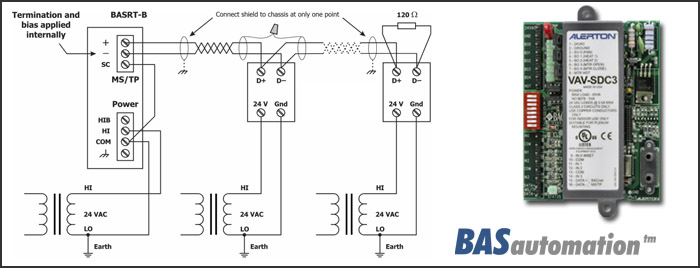Control Network Newsletter

Using the BASrouter with an Alerton Controller
March 2012 – Installing and operating the BASrouter (BASRT-B, 35 mm DIN-rail mount) with several Alerton controllers is simple and straightforward. Once the BASrouter is properly installed and configured, all the connected Alerton controllers can be accessible from BACnet/IP.
Alerton Controllers
Alerton manufactures a line of low-cost BACnet MS/TP controllers that can be accessible from BACnet/IP once the BASrouter is in place. Although there are several controller models, the information in the application note should be applicable to each model.
BACnet MS/TP data from the Alerton controllers are carried over a two-wire twisted-pair network. Alerton controllers auto-baud. They wait until a master device – usually a building controller – to send out frames so connected controllers can "wake-up"and set their speed to that of the building controller. The BASrouter takes the place of the building controller so its data rate must be set during configuration thereby allowing the Alerton controllers to automatically match their data rate with that of the BASrouter.
Wiring the BASrouter
A typical wiring diagram is shown. Like the BASrouter, the Alerton controllers incorporate a 24 VAC half-wave rectified power supply meaning that the BASrouter and the Alerton controllers can share the same AC power source as long as the COM pin on the BASrouter and the GND pin on the Alerton controllers are connected together. If separate power sources are used – as shown in the diagram – then an earth connection must be shared by the COM and GND pins. The BASrouter requires about 4 VA of power.
The Alerton controllers utilize a two-wire, non-isolated MS/TP network while the BASrouter supports a 3-wire isolated MS/TP network. If possible, install the BASrouter at one end of the MS/TP segment. This will be called the near-end. Follow Alerton cabling and grounding recommendations. Connect the data pair as shown observing polarity. A common ground reference is required in order for the MS/TP transceivers to operate properly. Connect the SC pin and the COM pins together on the BASrouter. Make sure an earth connection exists between all the controllers and the BASrouter when separate power sources are involved. This helps protect the data lines from excessive common-mode voltages that could damage the transceivers or create data errors. Do not exceed 63 controllers on a network. A maximum number of about 45 is recommended to improve responsiveness. Apply a 120-ohm terminator to the last controller on the far-end of the MS/TP segment. The BASrouter has internal bias and termination applied so the near-end is already terminated and should not receive an external terminator. If the BASrouter is installed mid-span, termination and bias can be disabled by removing jumpers inside the BASrouter. In this situation, external bias and termination would need to be applied at the near-end while external termination is applied to the far-end.

|